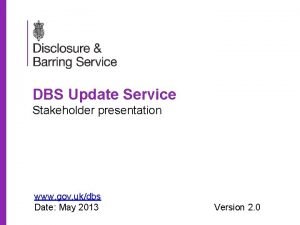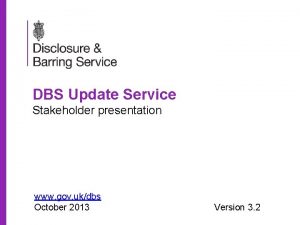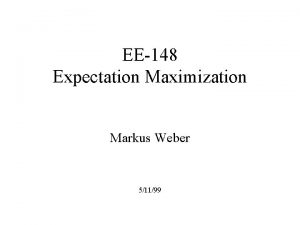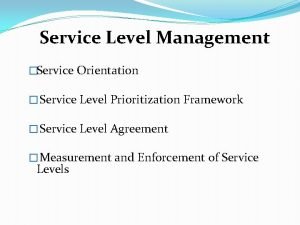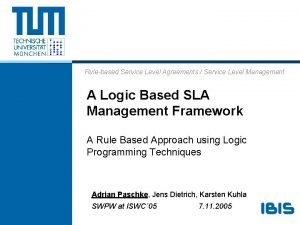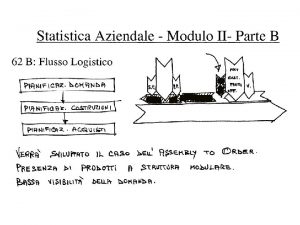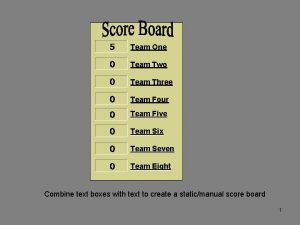Design Team A Service Level Expectation SLE Update

























- Slides: 25

Design Team A Service Level Expectation (SLE) Update CWG – Working Group

Background • Service Level Expectation (SLE) Design Team (DT) is comprised of 3 g. TLD Registry representatives and 3 cc. TLD Representatives • The DT was asked: • • To review the current IANA functions operations To review and evaluate existing SLEs between IANA and NTIA Work with IANA staff to capture the current work flow processes Develop new SLEs that reflect both the current work flow and customer performance

Summary of Recommendations so far • Current performance standards in NTIA/IANA agreement inadequate for registry service of global importance. • Appropriate time for customers to determine minimally acceptable service levels, reporting requirements and breach levels • Not recommending any changes to the process • Recommending mechanisms put in place prior to transition that measure, record, and extract transaction times • Recommend additional reporting mechanisms that promote transparency for IANA process

Guiding Principles of the Process (1) • Attributable measures. Unless clearly impractical, individual metrics should be reported attributing time taken to the party responsible. For example, time spent by IANA staff processing a change request should be accounted for distinctly from time spent waiting for customer action during a change request. • Overall metrics. In addition to the previous principle, overall metrics should be reported to identify general trends associated with end-to-end processing times and processing volumes. The raw performance data should continue to be freely available to third parties to conduct their own analysis. • Relevance. All metrics to be collected should be relevant to the validation of customer service. In addition some are customer critical metrics that are considered important to set specific thresholds for judging breaches in ICANN’s ability to provide an appropriate level of service. • Clear definition. Each metric should be sufficiently defined such that there is a commonly held understanding on what is being measured, and how an automated approach would be implemented to measure against the standard.

Guiding Principles of the Process (cont’d) • Definition of thresholds. The definition of specific thresholds for performance criteria should be set to ensure minimally acceptable service levels. Thresholds are expected to change over time to drive improvements in service levels. Initial thresholds may be based on analysis of actual data or this may require first the definition of a metric, a period of data collection, and later analysis by IANA customers before defining the threshold. • Review process. The service level expectations should be reviewed periodically, and adapted based on the revised expectations of IANA’s customers and relevant updates to the environment. They should be mutually agreed between the community and the IANA Functions Operator. • Regular reporting. To the extent practical, metrics should be regularly reported automatically and without delay as and when collected.

Process • Collected and statistically processed historical processing times (attached in the presentation) • The numbers showed IANA was much better than its SLEs but more granularity and transparency was needed. • DT-A began working with IANA to map out their process in more detail and develop more detailed SLEs • In realizing that the process is going to require more time to develop SLEs with transparency; the DT-A issued a statement to the CWG that it will continue to work in parallel to the transition, and ensure a robust SLE is in place post transition

Next Steps • IANA and Adam Smith (Community DNS) will refine the processes and SLEs and present weekly to DT-A for comment. – (4 weeks) • Once agreed, IANA will develop an Implementation plan (2 weeks) including an internal ICANN request for Technical Resources. • Request approval from NTIA (2 weeks) • Deploy resources to capture actual data (1 month) • IANA will then for 2 to 3 months run a trial capturing real world transaction information and provide that to the DT • Populate the agreed thresholds for the SLEs based upon real world data • With the SLE data specified the SLE will be in place for the Implementation Phase. (Jan/Feb 2016) • Checking of the SLE during the Implementation Phase • SLE in place from the date of Transition Note: ICANN have not formally agreed to the draft Timetable, IANA have indicated that subject to management approval they could work with

Backup Data Slides DT-A Subgroup

Root Zone and WHOIS Database Changes (09/13 -01/2015*) Numberof Occurances 108 102 Mean = 3. 721 days Mode = 2 days Median= 3 days Standard Deviations - 3. 939 Days 70 64 55 48 46 22 14 0 1 2 3 4 5 6 7 Number of Days to Implement Change 8 4 5 4 1 9 10 11 12 *IANA published performance dat

Notes to All Data Slide • All Root Zone and WHOIS Database Changes – cc. TLD, g. TLDs, & IDNs • Calculating the time it took from receipt of registry validation to completion verification • Measured in total number of days (including weekends) • Approximately 565 total data points – only 27 transactions took longer than 9 days and 13 took longer than 12 days (not on graph) • 4 transaction took longer than 1 year – data points were thrown out because could not confirm date that request was received • Overall Mean = 3. 721 days • Mode = 2 days • Median = 3 days • Standard Deviations - 3. 939 Days

Root Zone and WHOIS Database Changes cc. TLDs (09/13 -01/2015*) Number of Occurances 70 Mean 3. 975 days Mode = 2 days Median = 3 days Standard Deviations - 4. 107 Days 56 48 48 32 30 10 6 5 0 1 2 3 4 5 6 7 Number of Days to Implement Change 8 3 4 4 0 9 10 11 12 *IANA published performance data.

Notes to cc. TLD Slide • Root Zone and WHOIS Database Changes for cc. TLDs • Calculating the time it took from receipt of registry validation to completion verification • Measured in total number of days (including weekends) • 323 data points – a total on of only 7 transactions took longer than 11 days and only 18 took longer than 8 days to complete (not on graph) • Mean 3. 975 days • Mode = 2 days • Median = 3 days • Standard Deviations - 4. 107 Days

Root Zone and WHOIS Database Changes IDNs (09/13 -01/2015*) Numberof Occurances 10 Mean = 4. 364 days Mode = 3 days Median = 3 days Standard Deviations - 4. 184 Days 8 7 5 4 4 1 0 1 2 3 4 5 6 7 Number of Days to Implement Change 8 0 0 9 10 11 12 *IANA published performance dat

Notes to IDN Slide • Root Zone and WHOIS Database Changes for IDNs • Calculating the time it took from receipt of registry validation to completion verification • Measured in total number of days (including weekends) • 55 data points – a total on of only 4 transactions took longer than 8 days to complete (not on graph)…the tail • Mean = 4. 364 days • Mode = 3 days • Median = 3 days • Standard Deviations - 4. 184 Days

Root Zone and WHOIS Database Changes g. TLDs (09/13 -01/2015*) Numberof Occurances 39 36 32 Mean 2. 870 days Mode = 1 days Median = 2 days Standard Deviations - 3. 198 Days 18 17 15 10 5 0 0 1 2 3 4 5 Number of Days to Implement Change 6 7 8 *IANA published performance dat

Notes to g. TLD Delegation Slide • Root Zone and WHOIS Database Changes for g. TLDs • Calculating the time it took from receipt of registry validation to completion verification • Measured in total number of days (including weekends) • 176 data points – a total on of only 4 transactions took longer than 7 days to complete (not on graph)…the tail • Mean 2. 870 days • Mode = 1 days • Median = 2 days • Standard Deviations - 3. 198 Days

Delegation for g. TLDs and IDNs (09/13 -01/2015*) 103 Number of Occurances Mean 4. 95 days Mode = 5 days Median = 5 days Standard Deviations - 2. 346 Days 77 71 65 57 43 36 15 12 3 0 1 2 3 4 5 6 7 8 9 4 5 1 2 3 1 0 0 0 10 11 12 13 14 15 16 17 18 19 20 Number of Days to Implement Change *IANA published performance dat

Notes to g. TLD Slide • Delegation times for g. TLDs • Calculating the time it took from receipt of registry validation to completion verification • Measured in total number of days (including weekends) • 176 data points – a total on of only 4 transactions took longer than 7 days to complete (not on graph)…the tail • Mean 4. 95 days • Mode = 5 days • Median = 5 days • Standard Deviations - 2. 346 Days

Number of Days for Registries to Validate Requests (09/13 -01/2015*) Numberof Occurances 244 Mean = 3. 1973 days Mode = 0 days Median = 1 day Standard Deviation - 6. 311 Days 116 37 20 0 1 2 3 23 6 14 10 4 5 6 7 14 6 4 10 1 8 9 10 11 12 Number of Days to Implement Change 9 3 13 14 4 3 4 1 2 15 16 17 18 19 *IANA published performance data. 6 20

Notes to Registry Validation Slide • Validation times for all TLDs • Calculating the time it took from registry request to IANA’s receipt of validation • Note calculation was based registry request because IANA has an automated email response for validation, and actual times for the receipt of the email has been < 1 min; so the time difference is negligible. • Measured in total number of days for response • 563 data points – long tail – large Standard Deviation in comparison to the Mean • Mean = 3. 1973 days • Mode = 0 days • Median = 1 day • Standard Deviation - 6. 311 Days • It takes registries just as long or longer to respond to the validation email vs. IANA, NTIA, and Veri. Sign to implement the change.

Representative Transactions TLD Request Received Request Validated Request Dispatched Request Completed Days to Completed gov 8/29/2013 9/10/2013 0 md 9/2/2013 9/10/2013 0 monash 2/4/2014 2/5/2014 0 hk 6/27/2014 0 bio 7/11/2014 0 youtube 1/6/2015 0 zip 1/6/2015 0

Notes to Representative Transaction Slide • First two instances, . gov and. md, the response time to the validation email was longer than the completion of the request. • One request took one day, . monash, for the reply to the validation email and the remaining transactions were completed in less than one day, from request to confirmation.

IANA Transactions Completed vs. Weekday 140 143 142 123 117 120 112 106 105 95 106 100 96 106 98 95 108 95 75 67 33 27 17 8 Monday Tuesday Wednesday Requested Thursday Validated Dispatched Friday Completed 8 0 Saturday 1 Sunday 9

Notes to Days of the week slide • Graph shows on which day the transaction was completed • Importance is to show that measurements shown in the previous slides include weekend time and the mean is skewed to include the weekend • Depending on when the request is received, the processing time will be delayed for up to two days (because of the manual process)

Data Notes • Time to Implement Change is defined from the receipt of the validated request to the completed request verification received from Veri. Sign. • Four database change entries had time for change > 365 days. Could not confirm the original date of the request, so the data points were deem anomalies and removed. • All tails on the graphs are approximately >= 97. 5% of the total population, numbers beyond that are outliers and statistically insignificant in comparison to entire population. • All entries with a negative time to implement change were removed from the data population.
 Sle service level expectation
Sle service level expectation Expectation failure
Expectation failure Shadow paging recovery technique
Shadow paging recovery technique Drug induced sle
Drug induced sle Asuhan keperawatan lupus
Asuhan keperawatan lupus Anemia sle
Anemia sle Sapporo kriterleri
Sapporo kriterleri Calcinosis cutis
Calcinosis cutis Wat is sle
Wat is sle Dr jakab lászló immunológus
Dr jakab lászló immunológus Sle programación
Sle programación Takayasu arteritis
Takayasu arteritis Sle vasculitis
Sle vasculitis Lupus simptoms
Lupus simptoms Delimumab
Delimumab Rheumatoid arthritis vs osteoarthritis
Rheumatoid arthritis vs osteoarthritis Konsep keperawatan anak dengan penyakit kronis dan terminal
Konsep keperawatan anak dengan penyakit kronis dan terminal How is the value of a safeguard to a company calculated?
How is the value of a safeguard to a company calculated? Gov.ukdbs
Gov.ukdbs Www.gov.ukdbs-update-service
Www.gov.ukdbs-update-service Team spirit becomes team infatuation
Team spirit becomes team infatuation Team spirit becomes team infatuation
Team spirit becomes team infatuation The white team cheers for the blue team, just like
The white team cheers for the blue team, just like Expectation for webinar
Expectation for webinar Borns interpretation of wave function
Borns interpretation of wave function Expectation value of energy in quantum mechanics
Expectation value of energy in quantum mechanics


















